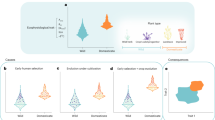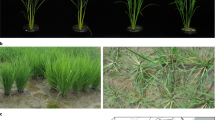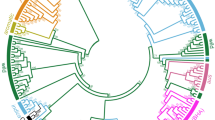Abstract
The selective forces imposed by agricultural practices have resulted in the evolution of agricultural races of weeds or agroecotypes. Some agroecotypes are intimately associated with a specific crop. Such associations can involve a system of mimicry, whereby the weed resembles the crop at specific stages during its life history and, as a result of mistaken identity, evades eradication. Mimetic forms of weeds are most likely to be selected by handweeding of seedlings or by harvesting and seed cleaning procedures. A striking example of morphological and phenological resemblance is found in the cultivated rice mimic,Echinochloa crus-galli var.oryzicola, a native of Asian rice fields but now widely distributed in rice-growing areas of the world. Comparative studies of the growth, devel-opment and patterns of phenotypic variation of cultivated rice,E. crus-galli var.oryzicola andE. crus-galli var.crus-galli demonstrate that the crop mimic is more similar to rice in many attributes than it is to its close relative. It is proposed that intense handweeding practices in Asia constitute the main selective force favoring the evolution of rice mimicry inE. crus-galli var.oryzicola.
Similar content being viewed by others
Literature Cited
Allard, R. W., R. D. Miller, and A. L. Kahler. 1978. The relationship between degree of environmental heterogeneity and genetic polymorphism.In Structure and Functioning of Plant Populations, A. H. J. Freyson and J. W. Woldendorp, ed, p. 49–69. North-Holland, Amsterdam.
Anderson, E. 1952. Plants, Man and Life. Univ. California Press, Berkeley.
Assemat, L., and H. I. Oka. 1980. Neighbour effects between rice (Oryza sativa L.) and barnyard grass (Echinochloa crus-galli Beauv.) strains. I. Aggressiveness and resistance to aggression as influenced by planting density. Acta Oecol./Oecol. Plant. 1: 371–394.
—, H. Morishima, and H. I. Oka. 1981. Neighbour effects between rice (Oryza sativa L.) and barnyard grass (Echinochloa crus-galli (Beauv.) strains. II. Some experiments on the mechanisms of interactions between plants. Acta Oecol./Oecol. Plant 2: 63–78.
Ayyangar, G. N. R., U. P. Rao, and T. V. Reddy. 1936. The inheritance of deciduousness of the pedicelled spikelets of sorghum. Curr. Sci. 5: 538.
Bachthaler, G. 1969. Development of the weed flora in Germany in relation to changes in method of cultivation. Angew. Bot. 43: 59–69.
Baker, H. G. 1965. Characteristics and modes of origins of weeds.In The Genetics of Colonizing Species, H. G. Baker and G. L. Stebbins, ed, p. 147–172. Academic Press, New York.
—. 1972. Migration of weeds.In Taxonomy, Phytogeography and Evolution, D. H. Valentine, ed, p. 327–347. Academic Press, London.
—. 1974. The evolution of weeds. Annual Rev. Ecol. Syst. 5: 1–24.
Bandeen, J. D., and R. D. McLaren. 1976. Resistance ofChenopodium album to triazine herbicides. Canad. J. PI. Sci. 56: 411–12.
Barrett, S. C. H. 1982. Genetic variation in weeds.In Biological Control of Weeds with Plant Pathogens, R. Charudattan and H. Walker, ed, p. 73–98. Wiley, New York.
—, and D. E. Seaman. 1980. The weed flora of Californian rice fields. Aquatic Bot. 9: 351–376.
—, and B. F. Wilson. 1981. Colonizing ability in theEchinochloa crus-galli complex (barnyard grass). I. Variation in life history. Canad. J. Bot 59: 1844–1860.
—, and —. 1983. Colonizing ability in theEchinochloa crus-galli complex (barnyard grass). II. Seed biology. Canad. J. Bot. 61: 556–562.
Bellue, M. K. 1932. Weeds of Californian seed rice. Monthly Bull. Calif. Dept. Agric. 21: 290–296.
Bilquez, A. F., and J. Lecomte. 1969. Relations entre mils sauvage et mils cultives: etude de L’hybridePennisetum typhoides Stapf. & Hubb. ×P. violaceum (Lam.) L. Rieh. Agron. Trop. 24: 249–257.
Bleier, H. 1929. Cytological investigation ofLens-Vicia hybrids. Genetica 11: 111–118.
Brown, A. H. D., E. Nevo, D. Zohary, and O. Dagan. 1978. Genetic variation in natural populations of wild barley (Hordeum spontaneum). Genetica 49: 97–108.
—, and D. R. Marshall. 1981. Evolutionary changes accompanying colonization in plants.In Evolution Today, G. G. E. Scudder and J. L. Reveal, ed, Proc. Second Int. Cong. Syst. and Evol. Biol., p. 351–353. Vancouver, British Columbia.
Brunken, J., J. M. J. deWet, and J. R. Harlan. 1977. The morphology and domestication of pearl millet. Econ. Bot. 31: 163–174.
Bunting, A. H. 1960. Some reflections on the ecology of weeds.In The Biology of Weeds, J. L. Harper, ed, Blackwell, Oxford.
Chirila, C., and A. Melachrinos. 1976. La flora vascolare delle risaie romene. Riso 15: 83–86.
Chu, Y., and H. I. Oka. 1970. Introgression across isolating barriers in wild and cultivatedOryza species. Evolution 24: 344–355.
Cohen, D. 1966. Optimizing reproduction in a randomly varying environment. J. Theor. Biol. 12: 119–129.
Crawford, D. J., and H. D. Wilson. 1977. Allozyme variation inChenopodium fremontii. Syst. Bot. 2: 180–190.
—, and —. 1979. Allozyme variation in several closely related diploid species ofChenopodium of the western United States. Amer. J. Bot. 66: 237–244.
Dave, B. B. 1943. The wild rice problem in the Central Provinces and its solution. Indian J. Agric. Sci. 13: 46–53.
de Wet, J.M.J., J. R. Harlan, and E. G. Price. 1976. Variability inSorghum bicolor. In Origins of African Plant Domestication, J. R. Harlan, J. M. J. de Wet, and A. B. L. Stemler, ed, p. 453–464. Mouton, The Hague.
Dmitriev, V.S. 1952. Concerning the primary source of origin of the flat-seeded vetch. Agrobiologija 1: 39–43.
Doggett, H., and N. Majisu. 1968. Disruptive selection in crop development. Heredity 23: 1–23.
Ehara, K., and S. Abe. 1950. Classification of the forms in the wild Japanese barnyard millet. Proc. Crop. Sci. Soc. Jap. 20: 245–246.
Fryer, J. D., and R. J. Chancellor. 1970. Herbicides and our changing weeds.In The Flora of a Changing Britain, Perring, F.H., ed, p. 105–118. Classey, Hampton.
Godwin, H. 1960. The history of weeds in Britain.In The Biology of Weeds, J. L. Harper, ed. p. 1–10. Blackwell, Oxford.
Gould, F.W., M. A. Ali, and D. E. Fairbrothers. 1974. A revision ofEchinochloa in the United States. Amer. Midi. Naturalist 87: 36–59.
Gregor, J.W. 1938. Reflections concerning new crop varieties. Herbage Rev. 6: 234–239.
—, and F. W. Sansome. 1927. Experiments on the genetics of wild populations. I. Grasses. J. Genet. 17: 349–364.
Gressel, J., and L. A. Segel. 1978. The paucity of plants evolving genetic resistance to herbicides: possible reasons and implications. J. Theor. Biol. 75: 349–371.
Grime, J.P. 1977. Evidence for the existence of three primary strategies in plants and its relevance to ecological and evolutionary theory. Amer. Naturalist 111: 1169–1194.
Grist, D. H. 1953. Rice. Longman, London.
Hammerton, J.L. 1968. Past and future changes in weed species and weed floras. Proc. 9th British Weed Control Conf. 3: 1136–1146.
Hamrick, J.L., Y. B. Linhart, and J. B. Mitton. 1979. Relationships between life history characteristics and electrophoretically detectable genetic variation in plants. Annual Rev. Ecol. Syst. 10: 173–200.
Hanson, N.S. 1962. Weed control practices and research for sugar cane in Hawaii. Weeds 10: 192–209.
Harlan, H.V. 1929. The weedishness of wild oats. J. Heredity 20: 515–518.
Harlan, J.R. 1970. The evolution of cultivated plants.In Genetic Resources in Plants—their Exploration and Conservation, O. H. Frankel, and E. Bennett, ed, p. 19–32. Blackwell, Oxford.
-. 1975. Crops and Man. Amer. Soc. Agron., Madison, WI.
-. 1981. The relationships between weeds and crops, (unpublished ms.).
—, J. M. J. de Wet, and E. G. Price. 1973. Comparative evolution of cereals. Evolution 27: 311–325.
Harper, J.L. 1956. The evolution of weeds in relation to resistance to herbicides. Proc. 3rd British Weed Control Conf. 1: 179–186.
—. 1977. Population Biology of Plants. Academic Press, London.
Heiser, C.B., and D. C. Nelson. 1974. On the origin of the cultivated chenopods (Chenopodium). Genetics 78: 503–505.
Hillman, G. 1981. Cereal remains from Tell Ilbol and Tell Qaramel.In The River Qoueiq, Northern Syria, and its Catchment, J. Matthers, ed, p. 503–507. B.A.R. International Series 98. B.A.R., Oxford.
Hitrovo, V. 1912. Sur la voilure des organes de propagation des plantes messicoles de niveaux differents. Bull. Angew. Bot. 5: 103–138.
Holliday, R.J., and P. D. Putwain. 1974. Variation in susceptibility to simazine in three species of annual weeds. Proc. British Weed Control Conf. 12: 649–654.
—, and —. 1977. Evolution of resistance to simazine inSenecio vulgaris L. Weed Res. 17: 291–296.
—, and —. 1980. Evolution of herbicide resistance inSenecio vulgaris: variation in susceptibility to simazine between and within populations. J. Appl. Ecol. 17: 779–792.
Holm, L.G., D. L. Plucknett, J. V. Pancho, and J. P. Herberger. 1977. The World’s Worst Weeds: Distribution and Biology. Univ. Hawaii Press, Honolulu.
Imam, M., and J. Kosinova. 1972. Studies on the weed flora of cultivated land in Egypt. Weeds of rice fields. Bot. Jahrb. Syst. 92: 90–107.
Jain, S.K. 1969. Comparative ecogenetics of twoAvena species occurring in central California. Evol. Biol. 3: 73–118.
Johnston, S.K., D. S. Murray, and J. Williams. 1979. Germination and emergence of balloonvine (Cardiospermum halicacabuni). Weed Sci. 27: 73–76.
Kalachevska, K. 1929. The mimicry of weeds. Acad. Sci. Ukraine. Kieff. Bull. Cl. Sci. Phys. Math. 4: 67–71.
Karper, R.E., and J. R. Quinby. 1947. The inheritance of callus formation and seed shedding in sorghum. J. Heredity 38: 211–219.
Kasahara, Y., and O. Kinoshita. 1952. Studies on the control of the barnyard grass on the paddy field. Proc. Crop. Sci. Soc. Jap. 21: 319–320.
Kennedy, R.A., S. C. H. Barrett, D. VanderZee, and M. E. Rumpho. 1980. Germination and seedling growth under anaerobic conditions inEchinochloa crus-galli (barnyard grass). Pl. Cell Environment 3: 243–249.
King, L.J. 1966. Weeds of the World: Biology and Control. Hill, London.
Kordan, H.A. 1972. Rice seedlings germinated in water with normal and impeded environmental gas exchange. J. Appl. Ecol. 9: 527–533.
—. 1974. The rice shoot in relation to oxygen supply and root growth in seedlings germinating under water. New Phytol. 73: 695–697.
Ladizinsky, G. 1975. Oats in Ethiopia. Econ. Bot. 29: 238–241.
Levin, D.A. 1975. Genie heterozygosity and protein polymorphism among local populations ofOenothera biennis. Genetics 79: 477–491.
McNeill, J. 1976. The taxonomy and evolution of weeds. Weed Research 16: 399–413.
Maltais, B., and C. J. Bouchard. 1978. Une moutarde des oiseaux (Brassica rapa L.) resistance a l’atrazine. Phytoprotection 59: 117–119.
Michael, P. 1973. Barnyard grass (Echinochloa) in the Asian-Pacific region, with special reference to Australia. Proc. 4th Asian-Pacific Weed Sci. Soc. Conf. Rotorua.
Monsi, M., Z. Uchijima, and T. Oikawa. 1973. Structure of foliage canopies and photosynthesis. Annual Rev. Ecol. Syst. 4: 301–328.
Moran, G.F., and D. R. Marshall. 1978. Allozyme uniformity within and variation between races of the colonizing speciesXanthium strumarium L. (Noogoora Burr). Austral. J. Biol. Sci. 31: 283–291.
Morishima, H., H. I. Oka, and W. T. Chang. 1961. Directions of differentiation in populations of wild rice.Oryza perennis andO. sativa f.spontanea. Evolution 15: 326–339.
—, K. Hinata, and H. I. Oka. 1963. Comparison of modes of evolution of cultivated forms from two wild rice species,Oryza breviligulata andO. perennis. Evolution 17: 170–181.
Nelson, A.P. 1965. Taxonomic and evolutionary implications of lawn races inPrunella vulgaris (Labiatae). Brittonia 17: 160–174.
Nevo, E., D. Zohary, A. H. D. Brown, and M. Haber. 1979. Genetic diversity and environmental associations of wild barleyHordeum spontaneum in Israel. Evolution 33: 815–833.
Oka, H.I., and W. T. Chang. 1959. The impact of cultivation on populations of wild rice,Oryza sativa f. spontanea. Phyton 13: 105–117.
—, and —. 1961. Hybrid swarms between wild and cultivated rice species,Oryza perennis andO. sativa. Evolution 15: 418–430.
Oliveira, L. 1977. Changes in ultrastructure of mitochondria of roots ofTriticale subjected to anaerobiosis. Protoplasma 91: 267–280.
Parker, C. 1977. Prediction of new weed problems, especially in the developing world.In Origins of Pest, Parasite, Disease and Weed Problems, J. M. Cherrett and G. R. Sagar, ed, p. 249–264. Blackwell, Oxford.
—, and M. L. Dean. 1976. Control of wild rice in rice. Pestic. Sci. 7: 403–416.
Pickersgill, B.P. 1981. Biosystematics of crop-weed complexes.In European Land Races of Cultivated Plants and their Evaluation, P. Hanelt, ed, Akademia Verlag, Berlin.
Pradet, A., and J. L. Bomsel. 1978. Energy metabolism in plants under hypoxia and anoxia.In Plant Life in Anaerobic Environments, D. D. Hook and R. M. M. Crawford, ed, p. 89–118. Ann Arbor Science Publications, Ann Arbor, MI.
Purseglove, J.W. 1972. Tropical Crops: Monocotyledons 1. Longman, London.
Radosevich, S.R. 1977. Mechanism of atrazine resistance in lambsquarters and pigweed. Weed Sci. 25: 316–318.
Ramakrishnan, P.S. 1968. Nutritional requirements of the edaphic ecotypes inMelilotus alba. New Phytol. 67: 147–157.
—, and U. Gupta. 1973. Nitrogen, phosphorus and potassium nutrition in the edaphic ecotypes inCynodon dactylon (L.) Pers. Ann. Bot. 37: 885–894.
—, and R. S. Jain. 1965. Differential response to calcium and growth yield of the edaphic ecotypes ofTridax procumbens L. J. Indian Bot. Soc. 44: 439–452.
Rowlands, D.G. 1959. A case of mimicry in plants—Vicia sativa L. in lentil crops. Genetica 30: 435–446.
Rumpho, M.E., and R. A. Kennedy. 1981. Anaerobic metabolism in germinating seeds ofEchinochloa crus-galli (barnyard grass). Metabolite and enzyme studies. PI. Physiol. 68: 165–168.
Salisbury, E.J. 1961. Weeds and Aliens. Collins, London.
Sauer, J.D. 1967. The grain amaranths and their relatives—a revised taxonomic and geographic survey. Ann. Missouri Bot. Gard. 54: 103–137.
Schwanitz, F. 1966. The Origin of Cultivated Plants. Harvard Univ. Press, Cambridge, MA.
Sculthorpe, C.D. 1928. The Biology of Aquatic Vascular Plants. Arnold, London.
Sinskaia, E.N. 1928. The oleiferous plants and root crops of the family Cruciferae. Trudy Prikl. Bot. 19: 1–619.
—. 1931. The study of species in their dynamics and interrelation with different types of vegetation. Trudy Prikl. Bot. 25: 1–97.
—, and A. A. Beztuzheva. 1931. The forms ofCamelina sativa in connection with climate, flax and man. Trudy Prikl. Bot. 25: 98–200.
Small, E. 1975. The case of the curious“Cannabis”. Econ. Bot. 29: 254.
Smith, R.J., and W. T. Fox. 1973. Soil and water and growth of rice and weeds. Weed Science 21: 61–63.
—, W. T. Flinchum, and D. E. Seaman. 1977. Weed control in U.S. rice production. USDA Agric. Handbook No. 497. Gov. Printing Office, Washington, DC.
Snaydon, R.W. 1970. Rapid population differentiation in a mosaic environment I. The response ofAnthoxanthum odoratum populations to soils. Evolution 24: 257–269.
—. 1978. Genetic changes in pasture populations.In Plant Relations in Pastures, J. R. Wilson, ed, p. 253–269. CSIRO, Melbourne.
—. 1980. Plant demography in agricultural systems.In Demography and Evolution in Plant Populations, O. T. Solbrig, ed, p. 131–160. Botanical Monographs Vol. 15. Univ. California Press, Berkeley.
—, and M. S. Davies. 1972. Rapid population differentiation in a mosaic environment. II. Morphological variation. Evolution 26: 390–405.
Solbrig, O.T., and B. B. Simpson. 1974. Components of regulation of a population of dandelions in Michigan. J. Ecol. 62: 473–486.
Souza Machado, V., J. D. Bandeen, W. D. Taylor, and P. Lavigne. 1977. Atrazine resistant biotypes of common ragweed and birds rape. Res. Rep. Canad. Weed Comm. (East Sec.) 22: 305.
Stapledon, R.G. 1928. Cocksfoot grass (Dactylis glomerata L.) ecotypes in relation to the biotic factor. J. Ecol. 16: 71–104.
Stebbins, G.L. 1950. Variation and Evolution in Plants. Columbia Univ. Press, New York.
Steenis, C. G. G. J. Van. 1957. Specific and infraspecific delimitation. Flora Malesiana ser. 1. 5.
Tedin, O. 1925. Verebung, Variation, und Systematik in der GattungCamelina. Hereditas 6: 275–386.
Turner, J.R.G. 1971. Studies of Mullerian mimicry and its evolution in burnet moths and heliconid butterflies.In Ecological Genetics and Evolution, R. Creed, ed, p. 224–260. Blackwell, Oxford.
VanderZee, D., and R. A. Kennedy. 1981. Germination and seedling growth inEchinochloa crusgalli var.oryzicola under anoxic conditions: structural aspects. Amer. J. Bot. 68: 1269–1277.
Vane-Wright, R.I. 1976. A unified classification of mimetic resemblances. Linn. Soc., Bio. 8: 25–56.
Vartapetian, B.B., I. N. Andreeva, and N. Nuritdinov. 1978. Plant cells under oxygen stress.In Plant Life in Anaerobic Environments, D. D. Hook and R. M. M. Crawford, ed, p. 13–88. Ann Arbor Science Publications, Ann Arbor, MI.
Vasinger-Alektrova, A.V. 1931. The weeds of rice in the southern part of the maritime region in the Far East. Trudy Prikl. Bot. 25: 109–152.
Vavilov, N.I. 1949. The origin, variation, immunity and breeding of cultivated plants. Chron. Bot. 13: 1–364.
Warwick, S.I., and L. Black. 1980. Uniparental inheritance of atrazine resistance inChenopodium album. Canad. J. PI. Sci. 60: 751–753.
—, and D. Briggs. 1978a. The genecology of lawn weeds. I. Population differentiation inPoa annua L. in a mosaic environment of bowling green lawns and flower beds. New Phytol. 81: 711–723.
—, and —. 1978b. The genecology of lawn weeds. II. Evidence for disruptive selection inPoa annua L. in a mosaic environment of bowling green lawns and flower beds. New Phytol. 81: 725–737.
—, and —. 1980. The genecology of lawn weeds. V. The adaptive significance of different growth habits in lawn and roadside populations ofPlantago major L. New Phytol. 85: 289–300.
—, V. Souza Machado, P. B. Marriage, and J. D. Bandeen. 1979. Resistance ofChenopodium strictum Roth (late-flowering goosefoot) to atrazine. Canad. J. PI. Sci. 59: 269–270.
Wiens, D. 1978. Mimicry in plants. Evol. Biol. 11: 365–403.
Welch, G.B. 1954. Seed processing equipment. Mississippi Agric. Exp. Sta. Bull. 520.
Whalen, M.D. 1979. Allozyme variation and evolution inSolarium section Androceras. Syst. Bot. 4: 203–222.
Wickler, W. 1968. Mimicry in Plants and Animals. McGraw-Hill, New York.
Wilkes, H.G. 1967. Teosinte: the Closest Relative of Maize. Bussey Inst. Harvard Univ. Cambridge, MA.
—. 1977. Hybridization of maize and teosinte in Mexico and Guatemala and the improvement of maize. Econ. Bot. 31: 254–293.
Wilson, H.D., and C. B. Heiser. 1979. The origin and evolutionary relationships of ‘Huauzontle’ (Chenopodium nutalliae Safford), domesticated chenopod of Mexico. Amer. J. Bot. 66: 198–206.
Yabuno, T. 1961.Oryza sativa andEchinochloa crus-galli var.oryzicola Ohwi. Rep. Kihara Inst. Bio. Res. 12: 29–34.
—. 1966. Biosystematic study of the genusEchinochloa. Jap. J. Bot. 19: 277–323.
Zinger, H.B. 1909. On the species ofCamelina andSperguiaria occurring as weeds in sowings of flax and their origin. Trudy Bot. Muz. Imp. Akad. Nauk 6: 1–303.
Author information
Authors and Affiliations
Rights and permissions
About this article
Cite this article
Barrett, S.H. Crop mimicry in weeds. Econ Bot 37, 255–282 (1983). https://doi.org/10.1007/BF02858881
Received:
Accepted:
Issue Date:
DOI: https://doi.org/10.1007/BF02858881




